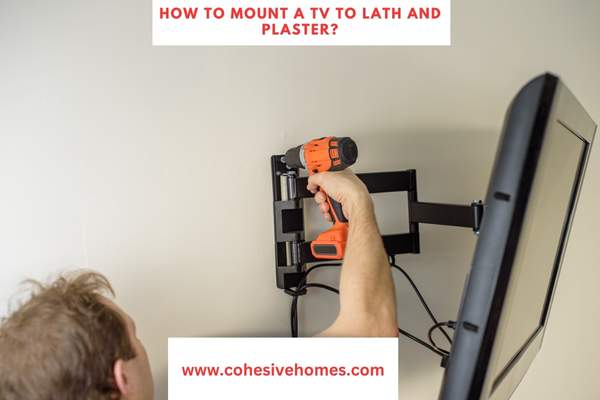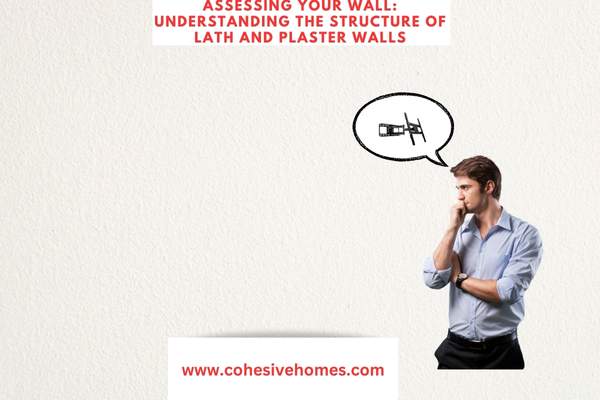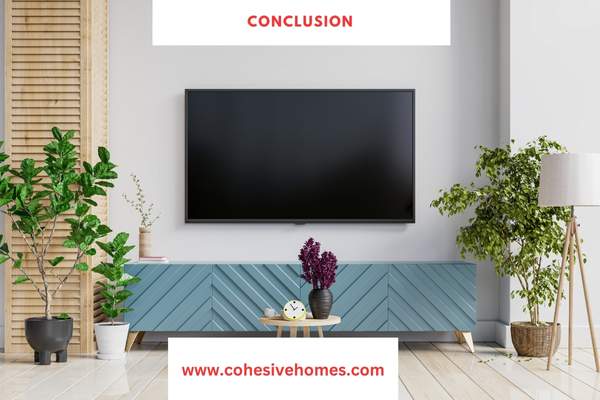
Mounting a TV to a lath and plaster wall can be a challenging task. While these walls are sturdy and provide excellent insulation, they can pose a challenge when it comes to hanging heavy items such as televisions. Mounting a TV to a lath and plaster wall requires careful planning, the right tools, and a bit of patience. In this blog post, we’ll discuss some tips and tricks to help you mount your TV to a lath and plaster wall with confidence, so you can enjoy your favorite shows without worry.
Can I really mount a TV on a lath and plaster wall?
Yes, you can mount a TV on a lath and plaster wall, but it requires special considerations and techniques compared to mounting a TV on other types of walls.
Assessing Your Wall: Understanding the Structure of Lath and Plaster Walls

Assessing your wall is the first step to mounting a TV on a lath and plaster wall.
Understanding the structure of lath and plaster walls is essential for a successful installation.
Lath and plaster walls consist of a wooden lath base with a layer of plaster on top.
The wooden lath base is made up of thin, long strips of wood that are nailed horizontally to the wall studs.
The plaster is then applied on top of the lath, which creates a strong and durable surface.
Lath and plaster walls are much denser and heavier than drywall, which means that they require more effort to drill into.
It’s essential to identify the wall’s studs and mount the TV bracket onto the studs to ensure that the bracket is firmly attached to the wall.
When drilling, it’s important to avoid hitting the lath because it can cause cracks in the plaster.
Additionally, the weight of the TV can cause the plaster to loosen over time, so it’s important to use a secure mounting bracket and check the bracket and TV periodically.
By assessing your wall’s structure and understanding its composition, you can prepare properly for mounting your TV and avoid any potential damage to your wall or TV.
Gathering the Right Tools and Materials for the Job

Before mounting your TV to a lath and plaster wall, it’s essential to gather the right tools and materials for the job.
You’ll need a stud finder to locate the studs behind the plaster, a level to ensure that the bracket is straight, and a drill with a masonry bit for drilling into the wall.
It’s important to select the right mounting bracket for your TV and wall type.
Check that the bracket is compatible with the size and weight of your TV and that it can be mounted on a lath and plaster wall.
You may also need additional hardware, such as screws and wall anchors, to secure the bracket to the wall.
When selecting your tools and materials, keep in mind the weight of your TV and the strength of your wall.
If your TV is particularly heavy or your wall is weak, you may need additional tools or materials to ensure a safe and secure installation.
Finding the Right Location: Determining the Best Place to Mount Your TV

Finding the right location for your TV is an important step in mounting it to a lath and plaster wall.
The ideal location will depend on several factors, including the size and shape of your room, the height of your ceiling, and the location of your furniture.
When determining the best place to mount your TV, consider the viewing angle and distance.
Mount the TV at eye level and position it at a comfortable viewing distance
If your room has windows or other light sources that create glare, it’s best to avoid mounting the TV in that area to ensure optimal viewing.
It’s also important to consider the location of electrical outlets and cable connections.
Mounting the TV near an electrical outlet will ensure that it’s easy to plug in, and mounting it near cable connections will minimize the amount of visible wiring.
Before you attach your TV to the wall, take some time to evaluate the space and choose the ideal location for it.
By picking the ideal spot, you can make sure that your TV is visible and that you can comfortably watch your favorite shows and movies.
Preparing Your Wall: Filling Holes, Patching Cracks, and Securing Loose Plaster

Preparing your wall is an important step in mounting a TV to a lath and plaster wall.
Before you begin the installation process, it’s essential to fill any existing holes, patch any cracks, and secure any loose plaster.
Start by filling any holes that may be present in the wall.
Use spackle or joint compound to fill the holes and smooth the surface.
Once the compound has dried, sand the surface lightly to create a smooth and even surface.
Next, patch any cracks in the plaster.
To fill small cracks, you can use spackle or joint compound, while larger cracks may require a plaster patching kit.
Follow the manufacturer’s instructions carefully to ensure that the patch adheres properly to the wall.
Finally, secure any loose plaster that may be present on the wall.
If the plaster is pulling away from the lath, use screws or washers to secure it back into place.
If the plaster is loose but still attached to the wall, use a plaster adhesive to reattach it to the lath.
The mounting process may encounter issues and affect the stability of the TV if there are any imperfections or loose plaster on the wall.
Marking Your Mounting Points: Using Stud Finders, Anchors, and Templates

Ensuring correct marking and alignment with wall studs is crucial to achieve stability, as the mounting points are the areas where the bracket will attach to the wall..
Start by using a stud finder to locate the wall studs behind the plaster.
Once you’ve located the studs, mark their locations on the wall using a pencil.
If the studs aren’t in the ideal location for mounting the TV, you may need to use wall anchors to secure the bracket to the wall.
To prevent any potential hazards resulting from a poorly mounted TV, you must mark the locations for inserting the anchors and select the appropriate size and type of wall anchor for your wall and TV weight.
To ensure that the bracket is level, use a template that matches the size of your bracket to mark the screw holes on the wall.
Align the template with the stud or anchor marks and use a pencil to mark the spots where the screws will be inserted.
Once you’ve marked your mounting points, it’s important to double-check that they’re level and correctly aligned before drilling into the wall.
This is essential to ensure that your mounted item hangs properly and securely.
Moreover, if your mounting points are not level or aligned correctly, it can compromise the stability of your mounted object and even damage your wall.
Therefore, taking the time to check the alignment and levelness of your mounting points before drilling is crucial.
Once you have confirmed the accuracy of your markings, you can proceed with confidence, knowing that your mounted object will be safely and securely affixed to the wall.
Testing Your Mount: Ensuring Your TV is Secure and Stable

It’s crucial to test the mount after attaching your TV to a lath and plaster wall to make sure it is solid and secure.
Testing the mount will provide you with peace of mind and confirm that your TV is safely secured and won’t fall or become dislodged.
Lift your TV carefully and check that it is securely attached to the bracket to test the mount.
Gently tug on the TV to ensure that it is securely mounted and will not move.
If the TV wobbles or feels loose, tighten the screws or adjust the bracket.
It’s also critical to make sure the wall mount is level.
Check that the TV is sitting straight and, if necessary, adjust the bracket.
If the mount isn’t level, it can put strain on the TV and compromise its stability.
Another essential step in testing the mount is checking that the cables are secure and won’t be pulled out of the TV or wall.
Check that the cables are neatly tucked behind the TV and are not under any tension or stress.
You can ensure that your TV is safely and securely mounted to the wall by testing your mount.
Addressing any issues or instability before fully installing the TV ensures its safety, providing you and your family with peace of mind.
Concealing Cords: Hiding Wires and Cables for a Clean, Professional Look

Concealing cords is an important step in mounting a TV to a lath and plaster wall.
Hiding wires and cables creates a clean, professional look and helps to prevent tripping hazards or damage to cables.
To get started, determine the route that the cables will take from the TV to the outlet and any other connected devices.
To prevent tripping hazards or for the wires to be visible, carefully plan the cable routing.
Once you’ve identified the cable path, you can use cable ties or cord clips to secure the cables to the wall or baseboards.
This will help keep the cables tidy and organized, ensuring they don’t become tangled or pose a tripping hazard.
Additionally, by securing the cables in place, you can prevent accidental disconnections or damage to the cords.
Therefore, it is important to take the time to properly secure your cables to ensure your electronics operate safely and efficiently.
If you’d like a more professional look, consider using a cable raceway or conduit to hide the cables.
These products come in various colors and allow for painting to match your wall color.
They create a sleek, professional look and help to protect your cables from damage.
Another option for concealing cords is to install an in-wall cable management system.
This involves cutting a channel into the wall and running the cables inside the wall.
This is a more advanced option and may require professional installation.
By concealing cords, you can create a clean, professional look for your mounted TV while keeping your cables organized and protected.
This can help to improve the overall appearance of the room and prevent accidents or damage to your cables.
Troubleshooting: Common Issues and How to Address Them

Even with proper planning and installation, sometimes issues can arise when mounting a TV to a lath and plaster wall.
Some common issues include loose brackets, uneven mounting, or cables that won’t reach the desired location.
Confirm that you firmly fasten the bracket to the wall and snug the screws if you’re experiencing problems with it.
You might need to tighten the screws or move the bracket if it’s not in the proper place.
Check to see if the wall is level, and adjust the bracket as necessary if you’re having mounting troubles.
The TV will be more solid and stable if the bracket is level.
If your wires won’t reach the intended area, consider utilizing cable extenders or moving your equipment closer to the TV.
You can also run the cables in a different direction or completely conceal them by using a cable raceway or conduit.
If you’re experiencing other problems, such as poor picture or sound quality, keep in mind to connect your cables securely and adjust your TV’s settings properly.
To solve problems or make repairs, you might occasionally need to consult a professional.
To guarantee that your TV is installed securely and safely.
Conclusion

Enjoying Your TV in Style with a Safe and Secure Mount. By following these tips and tricks, you can mount your TV to a lath and plaster wall safely and securely.
Take your time, gather the right tools and materials, and follow the manufacturer’s instructions carefully.
Mounting your TV securely and professionally requires a little patience and some elbow grease, but it’s worth the effort to enjoy your favorite shows and movies in style.
FAQS
Is it safe to mount a TV on a lath and plaster wall?
Yes, but you must use proper installation methods and tools.
Can I use regular wall anchors to mount a TV on a lath and plaster wall?
No, you must use specific anchors and installation techniques designed for lath and plaster walls.
Do I need professional help to mount a TV on a lath and plaster wall?
It depends on your experience level; if you’re unsure, it may be best to seek professional help.
